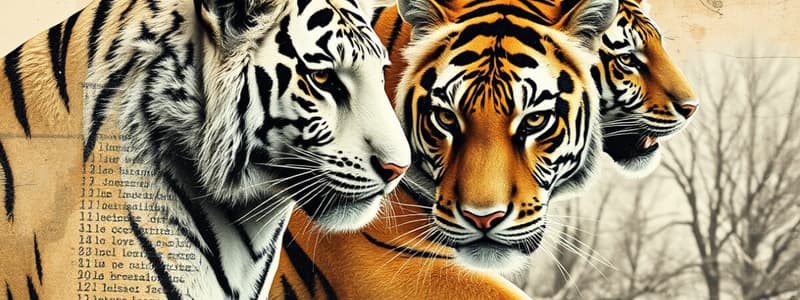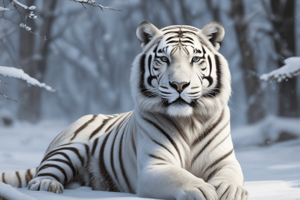Podcast
Questions and Answers
What is the largest species of dove mentioned?
What is the largest species of dove mentioned?
- Pygmy ground dove
- Rock dove
- Emerald dove
- Victoria crowned pigeon (correct)
What type of diet do hawks follow?
What type of diet do hawks follow?
- Carnivorous (correct)
- Herbivorous
- Insectivorous
- Omnivorous
How much of their body weight do hawks eat daily?
How much of their body weight do hawks eat daily?
- 5%
- 15%
- 8%
- 12% (correct)
What method do hawks primarily use to hunt their prey?
What method do hawks primarily use to hunt their prey?
Which of the following types of hawks is known to primarily consume small birds?
Which of the following types of hawks is known to primarily consume small birds?
What is a notable behavior hawks exhibit while practicing their hunting skills?
What is a notable behavior hawks exhibit while practicing their hunting skills?
What species do snow tigers actually belong to?
What species do snow tigers actually belong to?
What feature helps thorn bugs blend into their environment?
What feature helps thorn bugs blend into their environment?
What do horses primarily eat for their meals?
What do horses primarily eat for their meals?
Which type of habitat do crocodiles prefer for laying eggs?
Which type of habitat do crocodiles prefer for laying eggs?
Which of the following is NOT a dietary type of crabs?
Which of the following is NOT a dietary type of crabs?
What is the primary diet of hippopotamuses?
What is the primary diet of hippopotamuses?
How do non-flowering plants like ferns reproduce?
How do non-flowering plants like ferns reproduce?
What is a significant threat to dove populations?
What is a significant threat to dove populations?
Which type of lizard is known to exclusively eat insects?
Which type of lizard is known to exclusively eat insects?
What type of diet do most monkeys have?
What type of diet do most monkeys have?
What do doves primarily eat?
What do doves primarily eat?
How long can a dove live in captivity compared to in the wild?
How long can a dove live in captivity compared to in the wild?
What unique feature do howler monkeys have in their diet?
What unique feature do howler monkeys have in their diet?
What is one of the main parts of a tree?
What is one of the main parts of a tree?
How long can hippos graze for in one night?
How long can hippos graze for in one night?
How do most crabs obtain their food?
How do most crabs obtain their food?
Which characteristic is true about pigeons when compared to doves?
Which characteristic is true about pigeons when compared to doves?
Which term describes a life cycle?
Which term describes a life cycle?
What primarily makes doves and pigeons different in appearance?
What primarily makes doves and pigeons different in appearance?
Flashcards are hidden until you start studying
Study Notes
Snow Tigers
- Snow tigers are white Bengal tigers born without pheomelanin, leading to their snow-colored fur and dark stripes.
- They are not a separate species and are found only in captivity, such as zoos and circuses.
Horses
- Horses require a balanced diet for health and energy, primarily consuming grass and hay.
- When working hard, they may also eat concentrates made of grains like corn and oats, and they enjoy fruits, vegetables, sugar, and salt.
- Hydration is essential; horses drink a lot of water with their meals.
Crabs
- Over 4,000 species of crabs exist, with their diets varying according to their environments.
- Most crabs are scavengers and can be either carnivorous (meat-eaters) or omnivorous (consuming both plants and animals).
Hippopotamus
- Hippopotamuses are large African herbivores that primarily eat short grasses and can graze for up to six hours each night.
- Their feeding habits can significantly impact their environment, leaving behind noticeable trails.
Lizards
- There are thousands of lizard species with diets that depend on their types and habitats.
- Lizards can be herbivores, carnivores, omnivores, or specifically insectivores, which are lizards that eat only insects.
Monkeys
- Over 260 types of monkeys exist, with most being omnivores, although some specialize in certain diets.
- Howler monkeys primarily eat leaves (foliovores), while owl monkeys focus on fruits (frugivores). Capuchins are known for using tools for foraging.
Jellyfish
- Jellyfish are ancient, carnivorous invertebrates that have tentacles and oral arms to catch prey.
- They exist in large groups known as blooms and have no backbones.
Thorn Bugs
- Thorn bugs have a spiky, thorn-shaped horn for camouflage, resembling the plants they inhabit.
- They primarily feed on plant and tree sap and may cause damage to fruit trees, leading to their classification as pests.
Crocodiles
- Crocodiles inhabit various regions worldwide, thriving in tropical environments with accessible water and safe nesting sites.
- Development and habitat loss are significant threats to their populations.
Trees
- A tree consists of three main parts: the crown, trunk, and roots.
- The trunk has five layers: bark, cambium, heartwood, phloem, and xylem.
Plants
- Plants are categorized into flowering (angiosperms) and non-flowering (gymnosperms) species.
- Non-flowering plants reproduce using spores (e.g., ferns and mosses), while flowering plants utilize seeds.
Importance of Plants
- Plants play crucial roles in ecosystems, producing oxygen and food.
- Every part of a plant serves vital functions, such as roots absorbing water and leaves performing photosynthesis.
Botanists
- Botanists explore various plant types, including those that reproduce through spores and seeds.
- Non-flowering plants include ferns, mosses, and gymnosperms.
Pig Life Cycle
- The pig life cycle includes various stages: pregnancy in sows, birth of piglets, and reaching adulthood.
- Pigs age at five human years for each year, living about eight years in the wild but potentially over 15 years in captivity.
Doves
- Doves are universally recognized birds, symbolizing peace across many cultures and religions.
- They thrive in diverse environments except Antarctica, feeding mainly on insects, seeds, nuts, and fruits.
Pigeons
- Pigeons and doves belong to the same scientific family, Columbidae.
- Around 300 species of doves exist, with varying characteristics, typically featuring small heads and muscular wings.
Conservation of Doves
- Many dove species face endangerment, with nearly 60% at risk due to habitat loss, hunting, and predators.
- Several species have gone extinct, highlighting the need for conservation efforts.
Hawk Diet and Hunting
- Hawks are carnivorous birds of prey that hunt a variety of animals, including mammals, reptiles, fish, and insects.
- They have sharp talons and can capture prey much larger than themselves, consuming about 12% of their body weight daily.
Types of Hawks
- Different hawk species have specific dietary preferences; for example, Sharp-Shinned Hawks prefer small birds while Cooper's Hawks eat a broader range of animals.
Studying That Suits You
Use AI to generate personalized quizzes and flashcards to suit your learning preferences.




